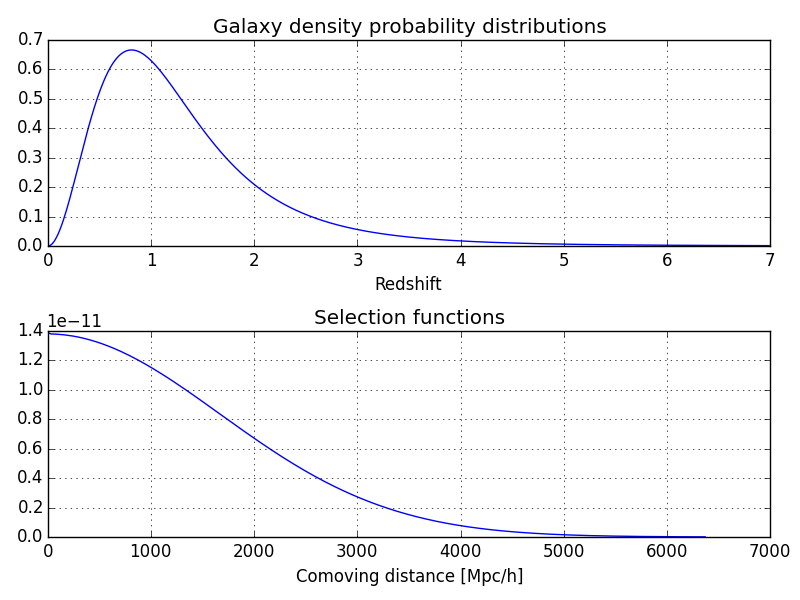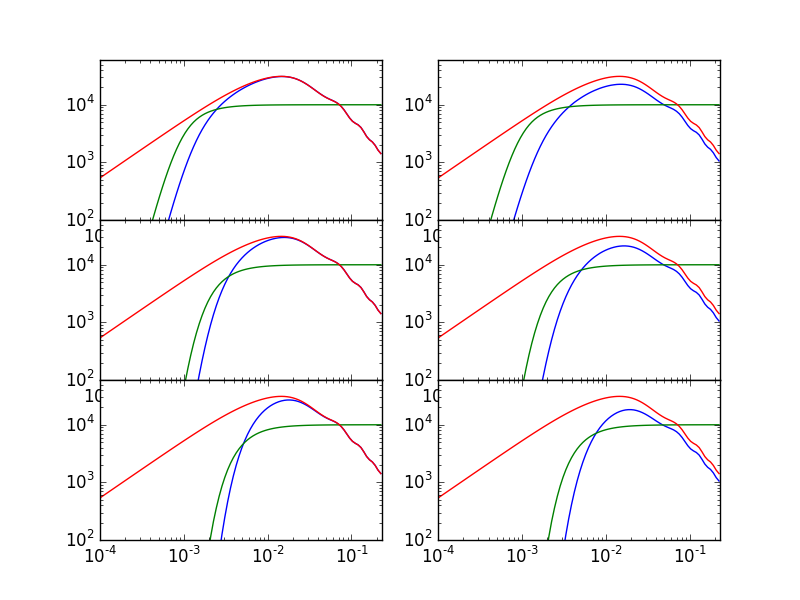3D SFB galaxy clustering¶
In this tutorial we use cosmicpy to recover some of the results from [YooDesjacques13].
Setting up the cosmology and the surveys¶
For this tutorial, we are going to use galaxy surveys following a Gaussian selection function of the form:
\[\Phi(r) = e^{-(r/r_0)^2}\]
Here, we are using \(r_0 = 2354 \quad h^{-1}\) Mpc. The resulting volume of the survey is computed for a Gaussian selection function using \(V = \pi^{3/2} r_0^3\).
The average galaxy density is set to \(\bar{n} = 10^{-4} (h^{-1} \mathrm{Mpc})^{-3}\) which corresponds to a total number of galaxies in survey \(N\) computed as:
\[N = \bar{n} V = 7,263,470\]
We create a survey following these parameters in cosmicpy using:
In [1]: from cosmicpy import *
In [2]: cosmo = cosmology()
In [3]: r0 = 2354.0
In [4]: survey_volume = pi**(3.0 / 2.0) * r0**3
In [5]: N = survey_volume * 10**(-4)
In [6]: ngal = N /(4.0* pi)/((180.0/pi)**2)/(60.0*60.0) # Conversion to gal/ arcmin^2
In [7]: surv = survey(nzparams={'type':'gaussian','cosmology':cosmo, 'r0':2354.0}, zmax=7.0, fsky=1.0, ngal=ngal, biastype='constant')
In [8]: surv.N # Checking the number of galaxies in the survey
Out[8]: 7263470.626200338
In [9]: surv.ngal # Checking the mean galaxy density per square arcmin
Out[9]: 0.048908749054432946
Below, we plot the selection function along with the normalized galaxy density distribution:
In [10]: z = arange(0.001,7.0,0.01)
In [11]: pz = surv.nz(z)
In [12]: r = cosmo.a2chi(z2a(z)) # Convert redshift array into comoving distance
In [13]: phi = surv.phi(cosmo,r) # Compute selection function for both survey
In [14]: figure(); subplot(211);
In [15]: xlabel('Redshift'); grid(); title('Galaxy density probability distributions');
In [16]: plot(z,pz);
In [17]: subplot(212);
In [18]: xlabel('Comoving distance [Mpc/h]'); grid(); title(r'Selection functions');
In [19]: plot(r,phi);

Computing 3D power spectra¶
In [20]: sp = spectra(cosmo,surv)
In [21]: l = [2, 5, 10] # Array of angular multipoles
In [22]: k = logspace(-4,-0.65,100) # Array of wavenumbers
In [23]: cl = sp.cl_sfb(l,k,shotNoise=False,evol=False)*(survey_volume**2)/r0*(2*sqrt(2*pi))
In [24]: cl_evol = sp.cl_sfb(l,k,shotNoise=False,evol=True)*(survey_volume**2)/r0*(2*sqrt(2*pi))
In [25]: cln = sp.cl_sfb(l,k,onlyNoise=True)*(survey_volume**2)/r0*(2*sqrt(2*pi))
In [26]: figure(); subplot(321);
In [27]: loglog(k,cl[0,:]); loglog(k,cln[0,:]); loglog(k,cosmo.pk_lin(k));
In [28]: ylim(1e2,6e4); xlim(0.0001,0.23);
In [29]: subplot(323);
In [30]: loglog(k,cl[1,:]); loglog(k,cln[1,:]); loglog(k,cosmo.pk_lin(k));
In [31]: ylim(1e2,6e4); xlim(0.0001,0.23);
In [32]: subplot(325);
In [33]: loglog(k,cl[2,:]); loglog(k,cln[2,:]); loglog(k,cosmo.pk_lin(k));
In [34]: ylim(1e2,6e4); xlim(0.0001,0.23);
In [35]: subplot(322);
In [36]: loglog(k,cl_evol[0,:]); loglog(k,cln[0,:]); loglog(k,cosmo.pk_lin(k));
In [37]: ylim(1e2,6e4); xlim(0.0001,0.23);
In [38]: subplot(324);
In [39]: loglog(k,cl_evol[1,:]); loglog(k,cln[1,:]); loglog(k,cosmo.pk_lin(k));
In [40]: ylim(1e2,6e4); xlim(0.0001,0.23);
In [41]: subplot(326);
In [42]: loglog(k,cl_evol[2,:]); loglog(k,cln[2,:]); loglog(k,cosmo.pk_lin(k));
In [43]: ylim(1e2,6e4); xlim(0.0001,0.23);
In [44]: subplots_adjust(hspace=0);

References¶
| [YooDesjacques13] | J. Yoo and V. Desjacques. All-sky analysis of the general relativistic galaxy power spectrum. PhysRevD, 88(2):023502, July 2013. arXiv:1301.4501, doi:10.1103/PhysRevD.88.023502. |
